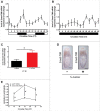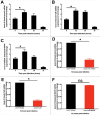Antimicrobial capacity of the freshwater planarians against S. aureus is under the control of Timeless
- PMID: 28051908
- PMCID: PMC5711420
- DOI: 10.1080/21505594.2016.1276689
Antimicrobial capacity of the freshwater planarians against S. aureus is under the control of Timeless
Abstract
Planarians, which are non-parasitic flatworms, are highly resistant to bacterial infections. To better understand the mechanisms underlying this resistance, we investigated the role of the circadian machinery in the anti-bacterial response of the freshwater planarian Schmidtea mediterranea. We identified Smed-Tim from S. mediterranea as a homolog of the mammalian clock gene Tim. We showed via RNA interference that Smed-Tim is required for the anti-microbial activities of Schmidtea mediterranea against Staphylococcus aureus infection during the light/dark cycle. Indeed, S. aureus infection leads to the expression of Smed-Tim, which in turn promotes Smed-Traf6 and Smed-morn2, but not Smed-p38 MAPK expression, 2 master regulators of planarian anti-microbial responses.
Keywords: MORN2; S. aureus; Tim; anti-bacterial response; planarians;.
Figures




Comment in
-
Planarian finds time(less) to fight infection.Virulence. 2017 Oct 3;8(7):1043-1048. doi: 10.1080/21505594.2017.1300735. Epub 2017 Mar 2. Virulence. 2017. PMID: 28277898 Free PMC article. No abstract available.
Similar articles
-
Staphylococcus aureus Promotes Smed-PGRP-2/Smed-setd8-1 Methyltransferase Signalling in Planarian Neoblasts to Sensitize Anti-bacterial Gene Responses During Re-infection.EBioMedicine. 2017 Jun;20:150-160. doi: 10.1016/j.ebiom.2017.04.031. Epub 2017 Apr 24. EBioMedicine. 2017. PMID: 28456423 Free PMC article.
-
Screening in planarians identifies MORN2 as a key component in LC3-associated phagocytosis and resistance to bacterial infection.Cell Host Microbe. 2014 Sep 10;16(3):338-50. doi: 10.1016/j.chom.2014.08.002. Cell Host Microbe. 2014. PMID: 25211076
-
Genetic expansion of chaperonin-containing TCP-1 (CCT/TRiC) complex subunits yields testis-specific isoforms required for spermatogenesis in planarian flatworms.Mol Reprod Dev. 2017 Dec;84(12):1271-1284. doi: 10.1002/mrd.22925. Epub 2017 Nov 10. Mol Reprod Dev. 2017. PMID: 29095551 Free PMC article.
-
[Regeneration of planarians: experimental object].Ontogenez. 2015 Jan-Feb;46(1):3-12. Ontogenez. 2015. PMID: 25898529 Review. Russian.
-
Basal bodies across eukaryotes series: basal bodies in the freshwater planarian Schmidtea mediterranea.Cilia. 2016 Mar 19;5:15. doi: 10.1186/s13630-016-0037-1. eCollection 2016. Cilia. 2016. PMID: 26998257 Free PMC article. Review.
Cited by
-
The Bacterial Metabolite Indole Inhibits Regeneration of the Planarian Flatworm Dugesia japonica.iScience. 2018 Dec 21;10:135-148. doi: 10.1016/j.isci.2018.11.021. Epub 2018 Nov 16. iScience. 2018. PMID: 30521984 Free PMC article.
-
Why study sleep in flatworms?J Comp Physiol B. 2024 Jun;194(3):233-239. doi: 10.1007/s00360-023-01480-x. Epub 2023 Mar 11. J Comp Physiol B. 2024. PMID: 36899149 Free PMC article. Review.
-
"Candidatus Trichorickettsia mobilis", a Rickettsiales bacterium, can be transiently transferred from the unicellular eukaryote Paramecium to the planarian Dugesia japonica.PeerJ. 2020 Apr 23;8:e8977. doi: 10.7717/peerj.8977. eCollection 2020. PeerJ. 2020. PMID: 32351785 Free PMC article.
-
The planarian Schmidtea mediterranea is a new model to study host-pathogen interactions during fungal infections.Dev Comp Immunol. 2019 Apr;93:18-27. doi: 10.1016/j.dci.2018.12.005. Epub 2018 Dec 17. Dev Comp Immunol. 2019. PMID: 30571995 Free PMC article.
-
Culturomics revealed the bacterial constituents of the microbiota of a 10-year-old laboratory culture of planarian species S. mediterranea.Sci Rep. 2021 Dec 21;11(1):24311. doi: 10.1038/s41598-021-03719-5. Sci Rep. 2021. PMID: 34934139 Free PMC article.
References
-
- Elliott SA, Sanchez Alvarado A. The history and enduring contributions of planarians to the study of animal regeneration. Wiley Interdiscip Rev Dev Biol 2013; 2:301-26; PMID:23799578; http://dx.doi.org/10.1002/wdev.82 - DOI - PMC - PubMed
-
- Abnave P, Mottola G, Gimenez G, Boucherit N, Trouplin V, Torre C, Conti F, Ben Amara A, Lepolard C, Djian B, et al.. Screening in planarians identifies MORN2 as a key component in LC3-associated phagocytosis and resistance to bacterial infection. Cell Host Microbe 2014; 16:338-50; PMID:25211076; http://dx.doi.org/10.1016/j.chom.2014.08.002 - DOI - PubMed
-
- Itoh MT, Shinozawa T, Sumi Y. Circadian rhythms of melatonin-synthesizing enzyme activities and melatonin levels in planarians. Brain Res 1999; 830:165-73; PMID:10350570 - PubMed
-
- Itoh MT, Igarashi J. Circadian rhythm of serotonin levels in planarians. Neuroreport 2000; 11:473-6; PMID:10718297 - PubMed
-
- Curtis AM, Bellet MM, Sassone-Corsi P, O'Neill LA. Circadian clock proteins and immunity. Immunity 2014; 40:178-86; PMID:24560196; http://dx.doi.org/10.1016/j.immuni.2014.02.002 - DOI - PubMed
Publication types
MeSH terms
Substances
LinkOut - more resources
Full Text Sources
Other Literature Sources
